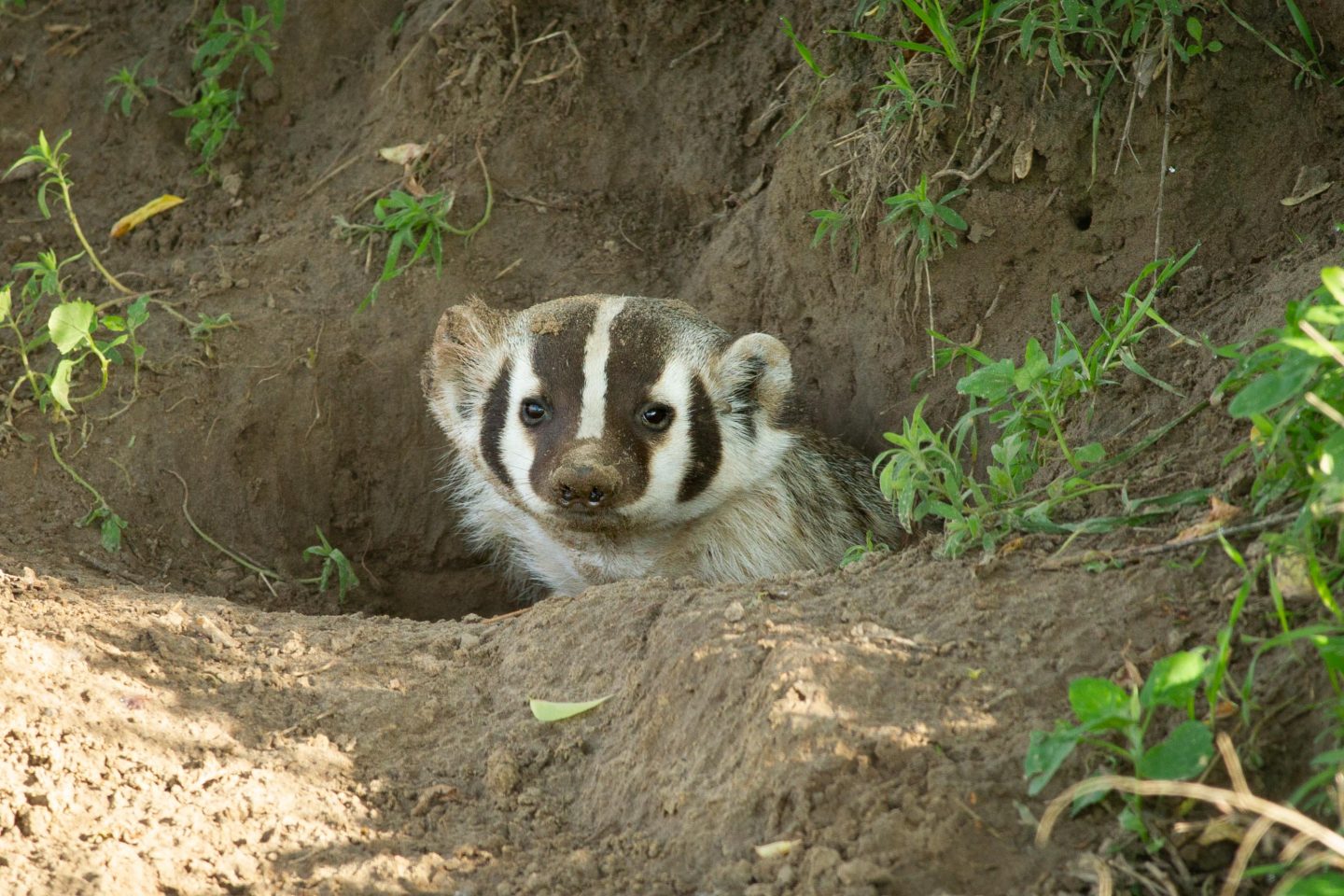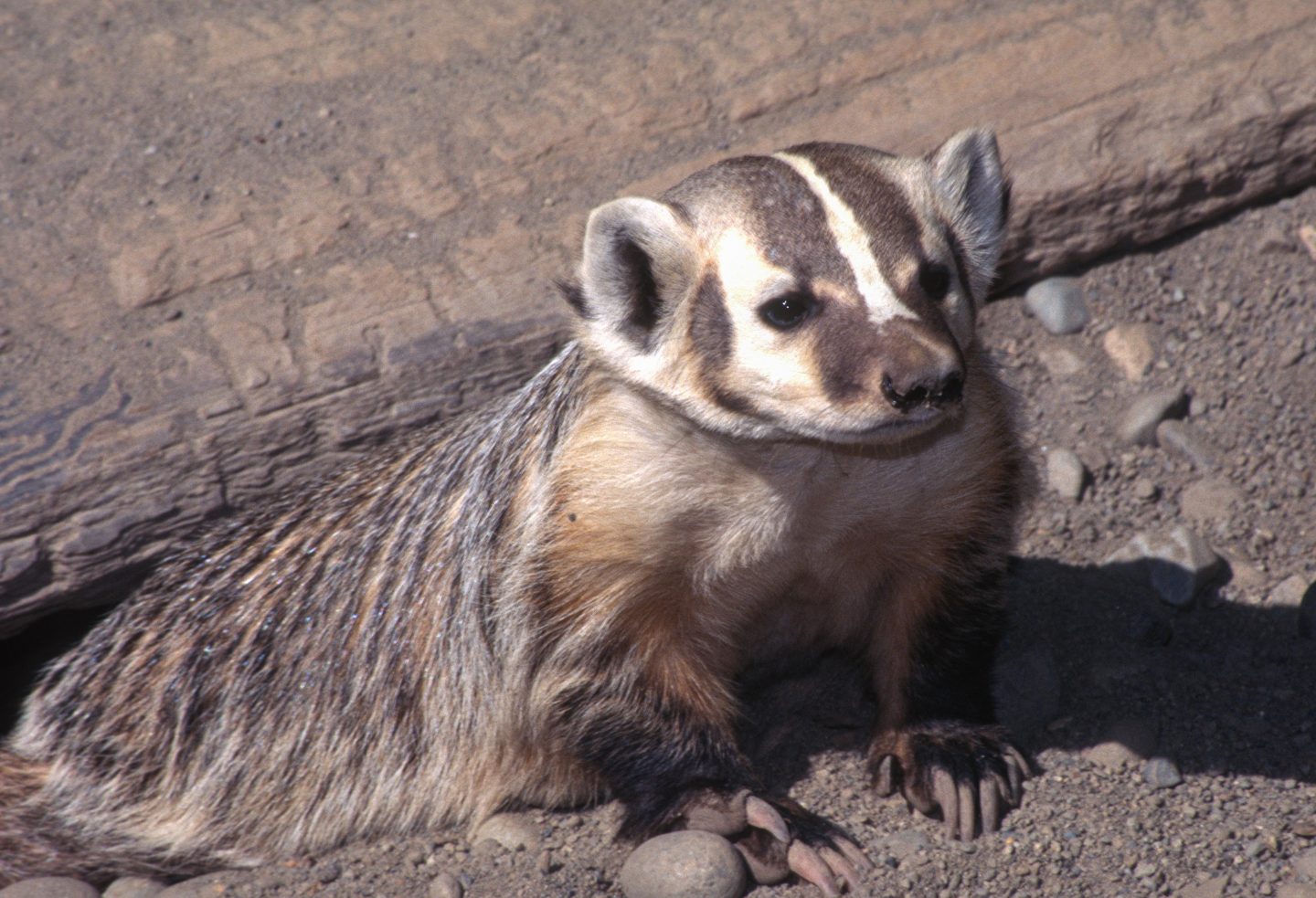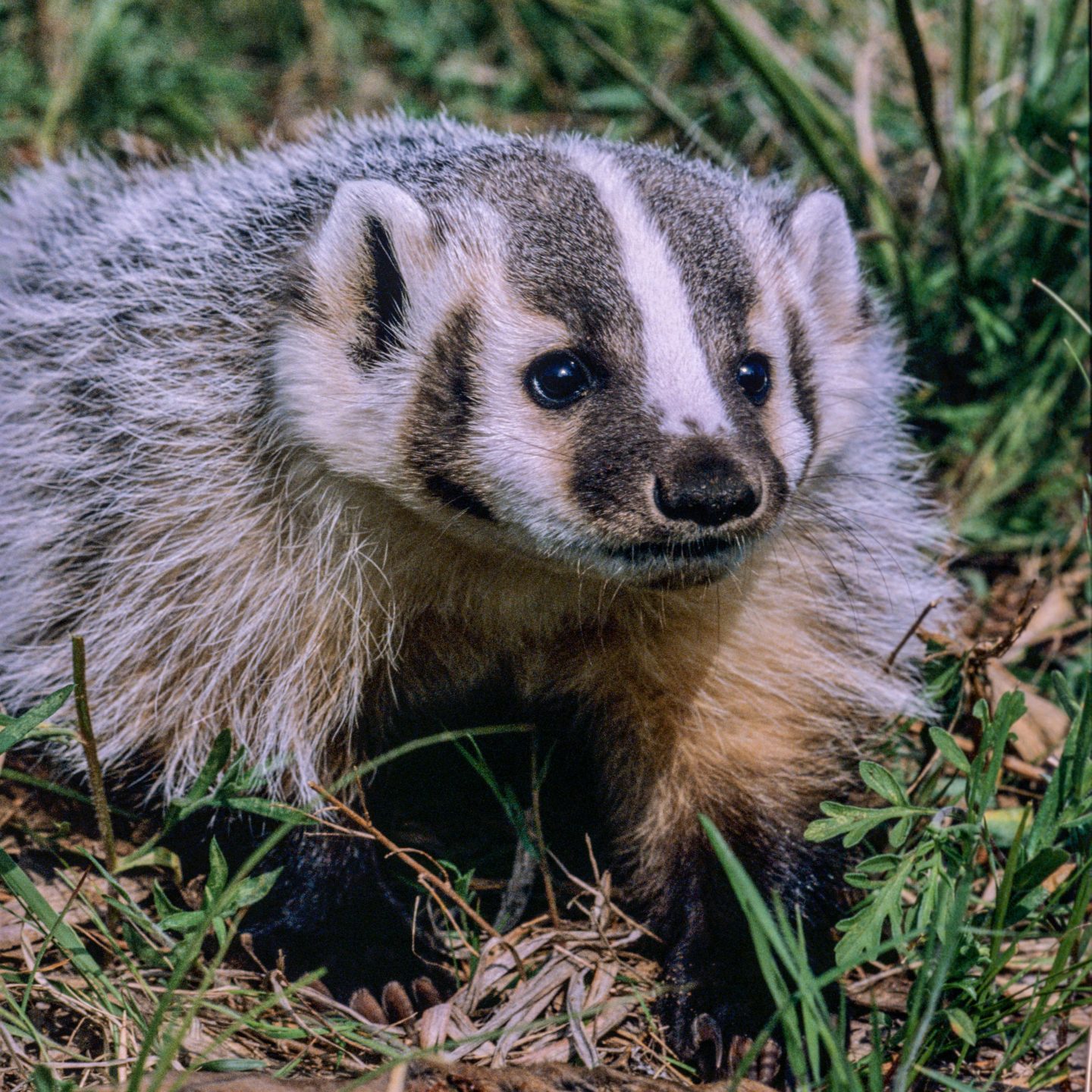
By Monica Macoubrie, Wildlife Education Specialist
When you hear the term “badger,” many might picture the infamous honey badger. Found in Africa, Southwest Asia and the Indian subcontinent, honey badgers are known for their fearless antics and viral videos. But let’s clear up the confusion: American badgers (Taxidea taxus) are not the same over-the-top daredevils. American badgers prefer a laid-back lifestyle and are more concerned with digging and foraging in Nebraska’s grasslands.
With their stocky bodies and seemingly grumpy faces, American badgers are the introverts of the Mustelidae family. They dig impressive burrows and primarily feast on small mammals and insects. So, while the honey badger is a social media star, our American badger is more like that friend who prefers staying in, munching on snacks and occasionally venturing out for a late-night treat.
Biology
American badgers are medium-sized mammals characterized by their robust bodies, short legs and powerful forelimbs, all of which are uniquely adapted for their burrowing, or fossorial, lifestyle. Adults typically weigh between 15 to 30 pounds, with males being larger than females. They measure about 24 to 30 inches long, including a tail that adds another 4 to 6 inches. Their fur is coarse and varies in color from grayish brown to tan, featuring unique white facial markings that include a stripe running from the nose, between the eyes and down the neck. This coloration provides effective camouflage in their natural habitats.
American badgers have exceptionally strong, elongated claws for digging. These powerful claws can grow up to 2 inches, allowing them to efficiently excavate extensive burrows in tough soil. Each claw’s slightly curved shape enhances grip, enabling badgers to unearth hidden prey and to navigate uneven terrain. Badgers can dig faster than any other mammal. The burrows and caves they inhabit are referred to as setts.
Additionally, badgers have keen senses, particularly their sense of smell, which they rely on to locate food. Although their eyesight is relatively poor, they compensate with acute hearing and the ability to detect movement, allowing them to navigate their environment effectively, even in low-light conditions.

Habitat
American badgers are commonly found in a variety of habitats across Nebraska, thriving primarily in grasslands, prairies and open woodlands. These environments provide the loose, sandy or loamy soils that are ideal for digging their extensive burrows. Their burrows serve not only as homes but also as protection from predators and harsh weather conditions.
In Nebraska, badgers favor areas with abundant vegetation, such as mixed-grass prairies and agricultural lands, where they can easily find their primary food sources. Additionally, they are often spotted near abandoned fields and along roadways, where their burrowing activities can aerate the soil and promote healthier plant growth. Badgers are less commonly found in dense forests or urban areas, as these habitats offer fewer foraging opportunities.
Reproduction and Life Cycle
American badgers have a unique reproductive cycle that typically begins in late winter to early spring. Mating usually occurs between February and May, with a gestation period lasting about 6 to 8 weeks. Female badgers, or sows, are known to exhibit a specific form of delayed implantation, meaning that after mating, the fertilized eggs do not immediately implant in the uterus but remain dormant for a period before developing. This adaptation allows the female to time the birth of her young, known as kits, to coincide with optimal environmental conditions and food availability.
In late spring to early summer, usually in May or June, the female gives birth to a litter of 2 to 5 kits, although larger litters can occur. The kits are born blind and helpless, relying entirely on their mother for warmth and nourishment. The mother will nurse them for about 8 to 10 weeks, during which they begin to grow rapidly. As they mature, the kits emerge from the burrow to explore their surroundings, learning essential survival skills from their mother.
By late summer, kits are usually weaned and start to accompany her on foraging trips. Young badgers remain with their mother for several months, gaining the necessary skills to fend for themselves before dispersing in the fall or winter to establish their own territories.
Diet
American badgers are opportunistic feeders with a diverse diet that primarily consists of small mammals, insects and occasionally reptiles and amphibians. Their keen sense of smell allows them to locate prey hidden underground, making them highly effective foragers. A significant portion of their diet includes rodents such as voles, mice and rabbits, which they capture by digging them out of their burrows.
Badgers are also known to consume insects, particularly during the warmer months, when they can find abundant supplies of beetles, grasshoppers and other invertebrates. In addition to small mammals and insects, American badgers may occasionally forage for fruit, such as berries, and roots, especially during late summer and fall when these food sources are more accessible. Their strong claws and powerful forelimbs enable them to excavate and exploit a wide range of dietary options.

Badgers and Coyotes Hunting Together
This might sound like something out of a children’s book, but it’s a real occurrence: Badgers and coyotes have formed a unique and fascinating hunting partnership that benefits both species. This mutual relationship is most often seen in open grasslands and prairies, where their complementary hunting strategies allow both to thrive.
Coyotes use their sharp eyesight and speed to chase down prey like rodents and rabbits, while badgers rely on their exceptional digging skills and keen sense of smell to uncover animals hiding underground. As the coyote corners or flushes out prey, the badger is close behind, digging out creatures like ground squirrels and pocket gophers that attempt to burrow to safety.
This collaboration allows them to access a wider range of food sources that neither species could efficiently exploit alone. Coyotes benefit from the badgers’ ability to dig out prey, while badgers gain access to prey they may not have otherwise come across without the coyotes’ hunting activity.
Furthermore, the presence of a badger can deter other potential predators from interfering with the coyotes’ hunt. This relationship enhances foraging success for both species and contributes to the overall ecological balance in their habitats.
American badgers are essential players in Nebraska’s ecosystems, contributing to soil health and controlling prey populations through their foraging and burrowing activities. While they might not be making headlines like the honey badger, American badgers deserve recognition for their role in the landscape.
